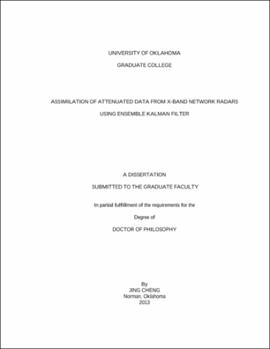| dc.contributor.advisor | XUE, MING | |
| dc.creator | Cheng, Jing | |
| dc.date.accessioned | 2019-04-27T21:26:12Z | |
| dc.date.available | 2019-04-27T21:26:12Z | |
| dc.date.issued | 2013 | |
| dc.identifier | 99192795702042 | |
| dc.identifier.uri | https://hdl.handle.net/11244/318682 | |
| dc.description.abstract | To use reflectivity data from X-band radars for quantitative precipitation estimation and storm-scale data assimilation, the effect of attenuation must be properly accounted for. Traditional approaches try to make correction to the attenuated reflectivity first before using the data. An alternative, theoretically more attractive approach builds the attenuation effect into the reflectivity observation operator of a data assimilation system, such as an ensemble Kalman filter (EnKF), allowing direct assimilation of the attenuated reflectivity and taking advantage of microphysical state estimation using EnKF methods for a potentially more accurate solution. | |
| dc.description.abstract | This study first tests the approach for the CASA (Center for Collaborative Adaptive Sensing of the Atmosphere) X-band radar network configuration through observing system simulation experiments (OSSE) for a quasi-linear convective system (QLCS) that has more significant attenuation than isolated storms. To avoid the problem of potentially giving too much weight to fully attenuated reflectivity, an analytical, echo-intensity-dependent model for the observation error (AEM) is developed and is found to improve the performance of the filter. By building the attenuation into the forward observation operator and combining it with the application of AEM, the assimilation of attenuated CASA observations is able to produce a reasonably accurate analysis of the QLCS inside CASA radar network coverage. Compared with foregoing assimilation of radar data with weak radar reflectivity or assimilating only radial velocity data, our method can suppress the growth of spurious echoes while obtaining a more accurate analysis in the terms of root-mean-square (RMS) error. Sensitivity experiments are designed to examine the effectiveness of AEM by introducing multiple sources of observation errors into the simulated observations. The performance of such an approach in the presence of resolution-induced model error is also evaluated and good results are obtained. | |
| dc.description.abstract | The same EnKF framework with attenuation correction is used to test different possible configurations of 2 hypothetical radars added to the existing network of 4 CASA radars through OSSEs. Though plans to expand the CASA radar network did not materialize, such experiments can provide guidance in the site selection of future X-band or other short-wavelength radar networks, as well as examining the benefit of X-band radar networks that consist of a much larger number of radars. Two QLCSs with different propagation speeds are generated and serve as the truth for our OSSEs. Assimilation and forecast results are compared among the OSSEs, assimilating only X-band or short-wavelength radar data. Overall, radar networks with larger downstream spatial coverage tend to provide overall the best analyses and 1-hour forecasts. The best analyses and forecasts of convective scale structure, however, are obtained when Dual- or Multi-Doppler coverage is preferred, even at the expense of minor loss in spatial coverage. | |
| dc.description.abstract | Built-in attenuation correction is then applied, for the first time, to a real case (the 24 May 2011 tornadic storm near Chickasha, Oklahoma), using data from the X-band CASA radars. The attenuation correction procedure is found to be very effective--the analyses obtained using attenuated data are better than those obtained using pre-corrected data when all the values of reflectivity observations are assimilated. The effectiveness of the procedure is further examined by comparing the deterministic and ensemble forecasts started from the analysis of each experiment. The deterministic forecast experiment results indicate that assimilating un-corrected observations directly actually retains some information that might be lost in the pre-corrected CASA observations by forecasting a longer-lasting trailing line, similar to that observed in WSR-88D data. In the ensemble forecasts, assimilating un-corrected observations directly, using our attenuation-correcting EnKF, results in a forecast with a more intense tornado track than the experiment that assimilates all values of pre-corrected CASA data. | |
| dc.description.abstract | This work is the first to assimilate attenuated observations from a radar network in OSSEs, as well as the first attempt to directly assimilate real, uncorrected CASA data into a numerical weather prediction (NWP) model using EnKF. | |
| dc.format.extent | 180 pages | |
| dc.format.medium | application.pdf | |
| dc.language | en_US | |
| dc.relation.requires | Adobe Acrobat Reader | |
| dc.subject | Precipitation forecasting | |
| dc.subject | Doppler radar | |
| dc.subject | Radar meteorology | |
| dc.subject | Kalman filtering | |
| dc.title | ASSIMILATION OF ATTENUATED DATA FROM X-BAND NETWORK RADARS USING ENSEMBLE KALMAN FILTER | |
| dc.type | text | |
| dc.type | document | |
| dc.thesis.degree | Ph.D. | |
| ou.group | College of Atmospheric & Geographic Sciences::School of Meteorology | |
